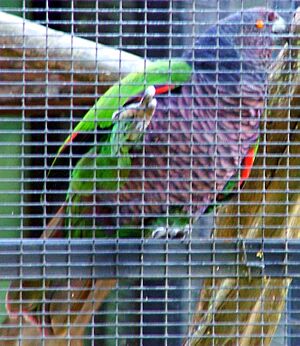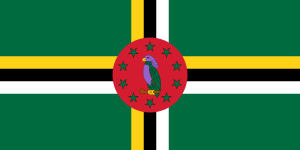Imperial amazon facts for kids
Quick facts for kids Imperial amazon |
|
|---|---|
 |
|
| At the Parrot Conservation and Research Centre, Roseau, Dominica | |
| Conservation status | |
| Scientific classification | |
| Genus: |
Amazona
|
| Species: |
imperialis
|
 |
|
The imperial amazon (Amazona imperialis), also known as the Dominican amazon or sisserou parrot, is a large parrot found only on the Caribbean island of Dominica. This beautiful bird is the national bird of Dominica. You can even see it on the country's flag! Sadly, the imperial amazon is a critically endangered species. This means it is very close to disappearing forever. In 2019, experts believed there were only about 50 adult birds left in the wild.
Contents
About the Imperial Amazon
The imperial amazon is a big parrot, usually about 48 centimeters (19 inches) long. Male parrots are heavier, weighing around 900 grams (2 pounds). Females are a bit lighter, at about 650 grams (1.4 pounds).
Like other parrots, the sisserou has special feet called zygodactyl feet. This means two toes point forward and two point backward. This helps them grip branches and food. They also have a strong, hooked beak and a muscular tongue. Their beak is perfect for moving food around easily.
Both male and female imperial amazons look the same. Their chest is a deep purple color. Their upper body and wing feathers are a dark green. The tips of their feathers have black edges. They have dark brown rings around their eyes, which are a mix of orange and red. Young parrots look similar but have more green feathers and brown eyes.
Behavior and Habits
The sisserou parrot makes loud, high-pitched calls. These sounds can be a mix of shrieks, squawks, and trills. These birds are quite shy and hard to get close to. They usually travel in small groups of three or fewer birds. Sometimes, they fly with red-necked amazon parrots.
Imperial amazons are excellent climbers and strong flyers. They have powerful wings that help them soar. They like to perch high up on the tops of trees. Their green and purple feathers help them blend in with the leaves. This makes them very hard to spot in the forest.
Reproduction and Life Cycle
Imperial amazons usually nest between February and April. The female lays two white eggs deep inside a hollow in a rainforest tree. They often use the same tree every year. The female sits on the eggs for about 26 to 28 days to keep them warm.
The chicks hatch and grow between June and early September. Both parents work together to feed and care for their young. They continue to feed the chicks until their feathers are fully grown. Young birds make "begging calls" when they are hungry. Their parents then bring them food. Usually, only one chick from the two eggs survives to leave the nest. Most sisserou pairs raise one chick every two years.
These parrots are very loyal and mate for life. They only look for a new partner if their mate dies. Sometimes, a bird might even grieve so much that it dies rather than find a new mate.
What They Eat
The sisserou parrot eats many different things. Their diet includes fruits, seeds, nuts, berries, blossoms, and palm shoots. They have several favorite foods. These include fruits from Dacryodes trees and Licania ternatensis. They also enjoy the flowers and seeds of Chimarcis cymosa. The nuts and young shoots of Euterpe palms are also a treat. They usually feed in the morning and evening.
Where They Live

The imperial amazon lives only on the Caribbean island of Dominica. It makes its home in mountain forest areas that are higher than 625 meters (2,100 feet). As Dominica's national bird, it is also featured on the country's flag.
These parrots are often found in the Morne Diablotins area in northern Dominica. They especially like the upper Picard River Valley. A small group of these parrots has also been reintroduced into the Morne Trois Pitons National Park.
Imperial amazons mostly live in mountain rainforests. Sometimes, they can be found in "elfin forests," which are forests with small, twisted trees. They usually live at elevations between 600 and 1300 meters (about 2,000 to 4,300 feet). However, they have sometimes been seen at lower elevations, around 150 to 300 meters (about 500 to 1,000 feet). This might be when they are looking for food.
Status and Conservation Efforts
The imperial amazon is a critically endangered species. This means it faces a very high risk of extinction in the wild. As of 2019, only about 50 adult birds were thought to be left. Many people are working hard to protect these parrots and their homes.
Organizations like Dominica's Forestry, Wildlife and Parks Division, and the Rare Species Conservatory Foundation (RSCF) are helping. They protect areas like the Northern Forest Reserve and the Central Forest Reserve. However, some areas next to these reserves are still not protected. Efforts are ongoing to protect more parts of Dominica.
Many groups have started programs to raise awareness and educate people. These programs also support research about the parrots. The education programs in Dominica have helped reduce the illegal bird trade. In 2011, the first imperial amazon was successfully bred by humans. This captive-bred parrot grew fully in 12 weeks. This success helped scientists learn more about how these parrots reproduce. The imperial amazon has a very low reproductive potential compared to other Amazona species. This means they don't have many chicks.
Threats to the Parrots
One of the biggest dangers to the imperial amazon is hurricanes. Hurricane David in 1979 and Hurricane Maria in 2017 caused huge damage to Dominica. These storms destroyed much of the parrots' habitat.
Another threat is habitat loss due to human activities. This includes selective logging and cutting down forests. Trapping the birds for food and trade is also a problem. Even though education has reduced the local market, illegal animal trading is still a big issue. These birds are sometimes hunted to be sold illegally. In the 1900s, efforts were made to ban all illegal bird captivity and trading. However, some foreign traders still try to hunt these birds. The growth of banana farms and other plantations has also reduced their habitat. Human development moving into their forest homes is a major concern for conservationists.
Imperial amazons also face competition for nesting spots. Red-necked amazons and owls sometimes try to use the same tree cavities. Imperial amazons only mate for a few months each year. They guard their nests for the rest of the year. Finding a good nesting site is very important for their chicks to survive and grow.
Finally, imperial amazons have natural predators. These include boa constrictors, broad-winged hawks, common opossums, and rats.
The Guadeloupe Amazon
There's a bird called the Guadeloupe amazon (A. violacea) that might be the same as the imperial amazon. Or, it could be a very close relative. Scientists have looked at old descriptions of the Guadeloupe amazon. These descriptions match what we know about the imperial amazon. A bone found on Marie-Galante island (between Dominica and Guadeloupe) was identified as A. violacea. This suggests that the imperial amazon might have lived on all three islands in ancient times. Or, perhaps they were traded between the islands.



